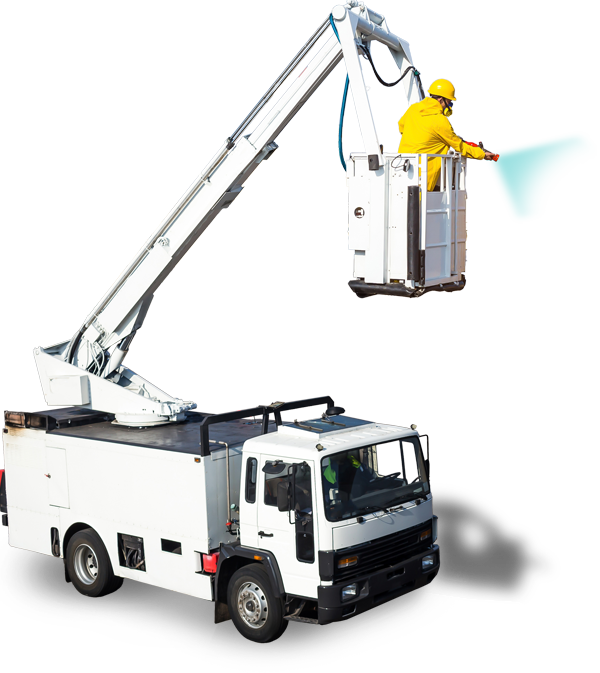De-Icing at the Airport: Why Smart Staff Planning Is Essential in Winter

De-Icing at the Airport:
Why Smart Staff Planning Is Essential in Winter
On October 15, the de-icing season officially kicks off at airports. Until April 30 of the following year, airports need to be prepared to de-ice aircraft with more than just a de-icing truck. Mid-October already? Yes, because it’s not just the weather that determines when de-icing is needed. The decision lies solely with the pilot. And de-icing can be required as early as October, for example, if an aircraft arrives with cold fuel tanks – depending on where it came from and needs to depart again quickly. In such cases, de-icing may be necessary even before winter really sets in to ensure a safe takeoff.
As the first frost approaches, it’s not just winter sports enthusiasts who start to feel the anticipation – aviation professionals do too, but for different reasons. Aircraft must be de-iced – a prelude to the winter season that brings with it its own kind of tension. De-icing isn’t just a technical procedure; it marks the beginning of de-icing readiness operations – a highly complex staffing challenge at airports. Whether everything runs smoothly is often decided before the plane even takes off. That’s why smart Workforce Management (WFM) is essential in this area.
Contents:
↓ Definition: What Does “De-Icing” Mean in Winter Operations and Why Is It So Critical?
↓ Who’s Involved and Why Is Workforce Management So Important?
↓ How Do You Determine Staffing Needs and How Do You Plan Accordingly?
↓ How Does Workforce Management Software Enable Efficient and Fair Staff Planning in Practice?
↓ Why Is the Interaction Between AI, Staff Planning, and Skill Management So Crucial in Aviation?
↓ What’s the Point – What’s the Goal?
Definition: What Does “De-Icing” Mean in Winter Operations and Why Is It So Critical?
“De-icing” refers to the targeted removal of ice, snow, or frost from aircraft surfaces – primarily from lift-generating parts such as the wings, tailplane, and sometimes the nose. The goal is to restore the aircraft’s aerodynamic properties, as even thin layers of ice can significantly reduce lift and compromise flight safety.
In practice, de-icing is typically performed using heated de-icing fluids that are sprayed onto the aircraft. Depending on weather conditions, a second phase may follow: anti-icing. This involves applying a different type of fluid designed to prevent new ice from forming before takeoff.
Why Is This So Critical?
Because de-icing isn’t about passenger comfort – it’s a safety-critical procedure that can determine whether a plane gets clearance for takeoff or remains grounded. Ice accumulation on aircraft wings alters airflow and can dramatically reduce lift, make flight behavior unpredictable, or in the worst case, cause a stall.
That’s why de-icing isn’t optional – it’s an essential requirement for safe departures under winter conditions. The process is time-sensitive, highly dependent on weather, and must be precisely coordinated with takeoff timing and approved flight slots within a tightly scheduled airspace. As a result, it has a direct and substantial impact on flight schedules, staffing resources, and overall airport logistics.
Who’s Involved and Why Is Workforce Management So Important?
At an airport, de-icing is a team effort – with clearly defined roles, different skill sets, and a high level of interdependence:

De-icing crews
consist of specially trained ground staff who operate de-icing vehicles. These teams must not only be well-coordinated but also ready for deployment at exactly the right time.

Dispatchers and coordinators
ensure that teams are positioned at the right aircraft at the right moment or that the aircraft are brought to the correct de-icing pad – often under intense time pressure, down to the minute.

Planners and workforce managers
are responsible for making this all happen from a staffing perspective. They need to account for shifts, on-call duties, certifications, and compliance with labor laws – all while managing unpredictable weather conditions.
This is precisely where workforce management (WFM) tools, such as plano-WFM, come into play. Instead of relying on rigid advance schedules, WFM enables dynamic, situational staff planning. It goes beyond time tracking – factoring in skills, availability, and operational requirements to ensure the right people are in the right place at the right time.
How Do You Determine Staffing Needs and How Do You Plan Accordingly?
Determining how much personnel is required for on-call service – especially for de-icing operations – is a central element of airport operational planning. This question cannot be answered with a one-size-fits-all approach, as it depends on a variety of dynamic factors. Efficient workforce planning must capture, analyze, and translate these variables in real time into concrete shift schedules.
1. Staffing Needs for De-Icing: A Complex Calculation
The foundation of any staffing plan is accurate forecasting. In aviation – particularly winter operations – this forecast is based on the following factors:
- Flight schedules:
How many departures are planned per hour? What types of aircraft are involved? - Weather data:
Temperature, precipitation, humidity, and wind determine if de-icing is required. - Aircraft-specific de-icing times:
Different aircraft types require varying amounts of time and personnel for de-icing. - Turnaround times:
The available time between arrival and scheduled departure must accommodate de-icing activities and be coordinated with airspace controllers. - Regulations and safety standards:
These define minimum staffing levels, mandatory breaks, and maximum working hours.
The challenge: these parameters are not static – they can change daily or even hourly.
2. Forecasting and Simulations: Technological Support Through WFM Systems
Modern workforce management systems – like plano WFM – use AI-powered demand forecasting. They combine historical data with real-time inputs from weather services, flight schedules, and operational systems. This enables detailed, hour-by-hour demand models that answer questions such as:
- How many de-icing teams are needed between 6 AM and 9 AM on a given day?
- What qualifications must staff have (e.g., operation of specific vehicles)?
- Are there flight schedule peaks that require additional shifts?
Simulating different scenarios (e.g., heavy snowfall vs. light frost) allows for proactive resource planning – giving shift managers and dispatchers clear guidance on how to act.
3. Efficient Staff Planning (WFP): More Than Just Assigning Shifts
Once the staffing needs are defined, operational planning begins: assigning available, qualified personnel to the required shifts while considering:
- Certifications and qualifications (e.g., de-icing vehicle operation, security clearances)
- Legal and contractual regulations (e.g., maximum working hours, rest periods, night shift premiums)
- Employee availability and preferences
- Short-notice rescheduling options in case of absences or changing weather
A smart WFM system not only manages the scheduling but also detects deviations and suggests automatic alternatives – such as skill matching or push notifications to qualified stand-ins.

Real-World Example:
De-Icing on a Snowy Morning
Imagine a morning with heavy snowfall. Based on weather forecasts and the flight schedule, the system predicts a spike in de-icing demand between 5:30 AM and 9:00 AM. While three teams might suffice on a normal day, the system anticipates the need for six teams – each consisting of a vehicle operator, a spotter, and a coordinator.
Thanks to a centralized qualifications database and real-time availability data, the operations center can create or adjust a plan within minutes – quickly filling gaps through mobile self-service features for employees.
Planning Is More Than Intuition – It’s Data-Driven, Dynamic, and Critical for Operations
Efficient staffing for airport de-icing operations requires a finely tuned combination of data analysis, experience, and intelligent software support. Only proactive workforce management ensures that the right number of qualified personnel is ready at the right time – without costly overstaffing, downtime, or risky shortages.
This means personnel aren’t just “scheduled,” but deployed purposefully, economically, and in full compliance – even under the unpredictable conditions of a winter morning on the ramp.
How Does Workforce Management Software Enable Efficient and Fair Staff Planning in Practice?
In practice, it’s not just about when and how many – it’s especially about who and how smartly personnel are deployed. This is where powerful workforce management (WFM) software really shines: bringing transparency, automation, and fairness to a high-pressure system.
Efficiency Through Automation
Gone are the days of manual Excel sheets and reactive phone chains. Modern WFM systems integrate directly with operational platforms like AODB (Airport Operational Database), weather services, and shift calendars. They automatically generate schedules from real-time data, identify conflicts – such as double bookings or violations of legal maximum working hours – and instantly propose optimized solutions, including last-minute rescheduling triggered by sudden temperature drops.
Fairness Through Rules and Preferences
A good WFM system considers not only operational requirements but also employee needs: Who prefers which shifts? Who worked night shifts recently? Are there requests for time off, vacations, or skill gaps? These parameters are automatically factored into the planning to distribute workload fairly and avoid employee burnout.
Traceability Through Transparency
Finally, the software provides a clear view of the schedule for everyone involved. Employees can see their shifts in a self-service portal, update availability, or swap shifts where allowed. Managers get instant insights into how well staffing needs are met, where bottlenecks may arise, and which skills might become scarce. This builds trust and reduces questions – even in the middle of a hectic winter operation.
Why Is the Interaction Between AI, Staff Planning, and Skill Management So Crucial in Aviation?
In the high-stakes airport environment, there’s no room for isolated solutions or standalone planning tools. What really matters is the seamless interplay – especially when speed is essential. Three elements are key:
Artificial Intelligence (AI)
AI transforms raw data into intelligent forecasts: How will the weather evolve over the next few hours? When should peak demand be expected? What is the likelihood of delays caused by de-icing? AI detects patterns, learns from historical operations, and calculates gross and net staffing needs within seconds – faster and more accurately than any human could.
Staff Planning
AI alone doesn’t schedule shifts. It’s the integration with a well-designed workforce management logic that turns predictions into actionable plans. This includes legal requirements, collective agreements, break regulations, time tracking, and workload data – the full framework that converts forecasts into concrete, operational staffing schedules.
Skill Management
Airports aren’t standardized workplaces – qualifications are critical. Who is authorized to operate which vehicle? Who knows the de-icing procedures for a Boeing 777? Who holds the necessary certifications and security clearances? Centralized skill management ensures exactly the right people are scheduled for the right tasks – completely, documented, and audit-ready.
Only through the combination of these three elements do airports achieve what they need in winter: predictable safety despite unpredictability. In other words: a responsive system that makes complexity manageable.
What’s the Point – What’s the Goal?
Efficient planning, fair shift distribution, smart technologies – all serve one overarching goal: stability in flight operations despite adverse conditions. Because in the end, a functioning de-icing plan affects far more than just an on-time departure.
Safe Takeoffs – Without Risk
The primary mission is clear: the safety of passengers and crew. Poorly planned or overburdened de-icing operations can cause departure delays, disrupt workflows, or in the worst case, lead to flight cancellations—with enormous costs and damage to reputation.
Operating Economically—Despite Weather Challenges
Every minute an aircraft stands idle costs money. Every late departure triggers cascading delays – not only for that flight but for all other resources it blocks. This makes precise resource deployment crucial – neither too scarce nor oversized. Only then can operations remain economically viable even under extreme conditions.
Securing Motivation – During the Toughest Time of Year
De-icing service means early shifts, freezing temperatures, and high pressure. Fair, transparent, and understandable scheduling is more than just a nice-to-have – it’s the foundation for motivation and reliability. Because only a well-coordinated, appreciated team performs under freezing conditions.
Conclusion:
Without smart tools, AI-supported planning, and a precise interplay of people, data, and machines, this process wouldn’t be efficient or safe.
So anyone who thinks winter airport logistics is “just about the cold” misses the true challenge:
It lies in the mindset – and the system behind it.
Would you like to learn more about workforce management with plano?
Further information about our workforce management software and its areas of application can be found here:
→ Workforce Management from plano
Archive
Employee Retention in Retail
We’re Here for You
